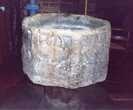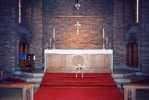Sneinton St CyprianFeatures and Fittings
 A
painted carved wooden figure approximately 45 inches high, Madonna and Child,
is displayed at the right hand side of the chancel entrance. The work has been
verified as being over 200 years old, and to originate in the Austrian Tyrol.
It was presented to the church by the architect, Mr C Howitt who had owned
it for several years, storing it at his office. A
painted carved wooden figure approximately 45 inches high, Madonna and Child,
is displayed at the right hand side of the chancel entrance. The work has been
verified as being over 200 years old, and to originate in the Austrian Tyrol.
It was presented to the church by the architect, Mr C Howitt who had owned
it for several years, storing it at his office.
There is an original drawing of the proposed church presented
by the architect. The southeast vestry (near the east door) is shown on the
drawing but was never built due to shortage of funds.
 A
carved obeche wooden figure depicting St Cyprian is located at the west
end of the church. The figure was carved by Mr George Rose in 1963 at the request
of a former church warden as a memorial to his wife. A
carved obeche wooden figure depicting St Cyprian is located at the west
end of the church. The figure was carved by Mr George Rose in 1963 at the request
of a former church warden as a memorial to his wife.
Mr Rose also carved the wooden plaque which is displayed on the south wall
of the chancel in memory of the Rev Varteg Evans.
 The
font is by far the oldest item in the church. It is believed to be 13th/14th
Century and is documented as having been found in a field between Gedling and
Shelford, a few miles away to the east of St Cyprian’s. At the time
of its discovery it was in use as a horse trough; the damage on the rim of
the font is attributed to contact with the horses’ tack. The font’s
original location is thought to have been Saxondale chapel, which was part
of Shelford Priory. The chapel was demolished
to save the costs of its upkeep some time in the 15th Century. When found it
was first offered to other churches, eventually finding a home in the mission
church of St Michael and All Angels, Foxhill Road, only ten minutes walk
from St Cyprian’s (now the site of another church). From there it
was moved to St Cyprian’s old church, and finally to its present
resting place. The
font is by far the oldest item in the church. It is believed to be 13th/14th
Century and is documented as having been found in a field between Gedling and
Shelford, a few miles away to the east of St Cyprian’s. At the time
of its discovery it was in use as a horse trough; the damage on the rim of
the font is attributed to contact with the horses’ tack. The font’s
original location is thought to have been Saxondale chapel, which was part
of Shelford Priory. The chapel was demolished
to save the costs of its upkeep some time in the 15th Century. When found it
was first offered to other churches, eventually finding a home in the mission
church of St Michael and All Angels, Foxhill Road, only ten minutes walk
from St Cyprian’s (now the site of another church). From there it
was moved to St Cyprian’s old church, and finally to its present
resting place.
 In
keeping with the rest of the church fittings, the altar is also of limed oak.
A central panel, inset with a depiction of a seated St Cyprian, occupies
half the altar front, with smaller plain panels on both sides separated by
narrow raised panels. Raised upon three full-width steps and approached over
a red carpet, the altar with minimal adornment quietly dominates the church
from whichever point it is viewed. In
keeping with the rest of the church fittings, the altar is also of limed oak.
A central panel, inset with a depiction of a seated St Cyprian, occupies
half the altar front, with smaller plain panels on both sides separated by
narrow raised panels. Raised upon three full-width steps and approached over
a red carpet, the altar with minimal adornment quietly dominates the church
from whichever point it is viewed.
It is recorded that the 18th Century wrought-iron altar rails (attributed
to a local craftsman and known to have been removed from St
Mary’s Nottingham), and which were installed in the old building,
were to be transferred to the new one. The present rails are of wood matching
the rest of the interior, and bear a carved GG in acknowledgement of the Girl
Guide company attached to the church which donated them. It is not clear what
happened to the iron rails.
The choir stalls are of light oak, but were not part of the original fixtures.
Like the congregation, the choir was seated on chairs until 1963 when the stalls
were installed.
The latest addition to the church is a new limed oak cross
suspended from the nave ceiling at the entrance to the chancel. This was carved
by Mr John Heaps, a parishioner, and installed in December 2002.
| 











